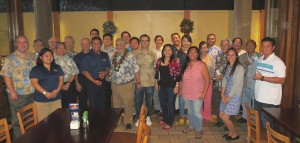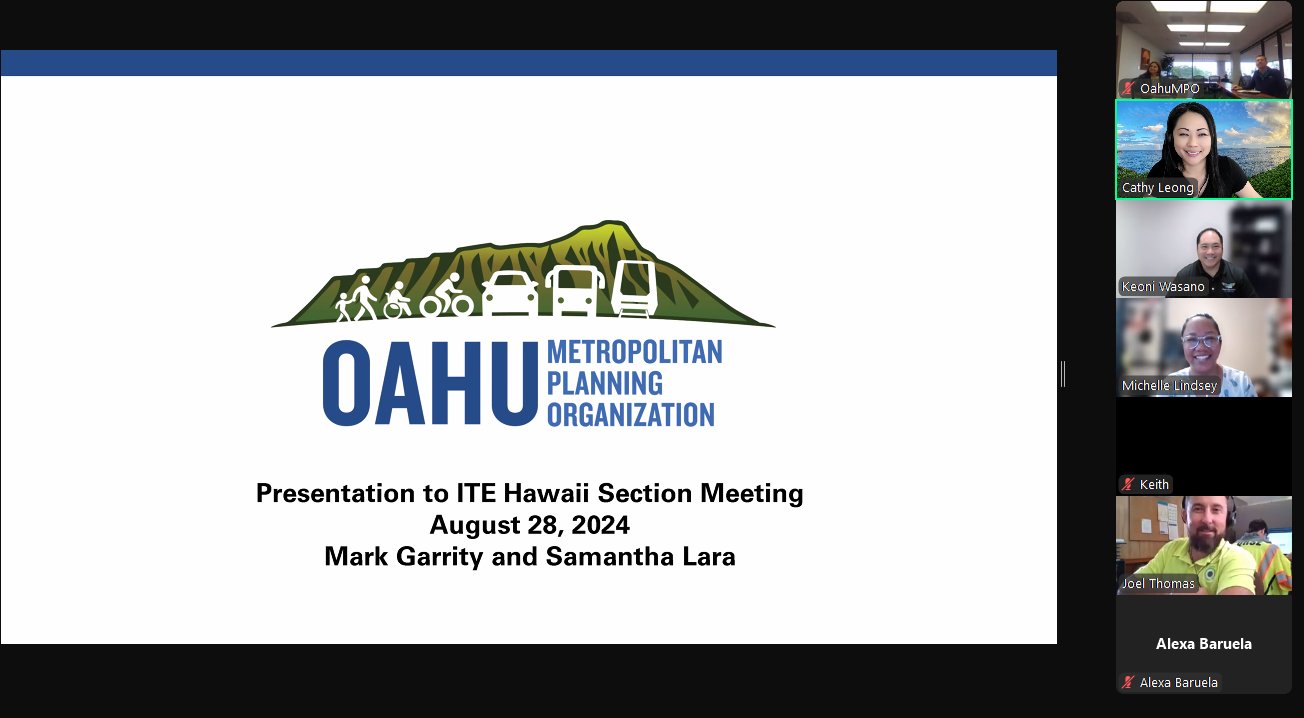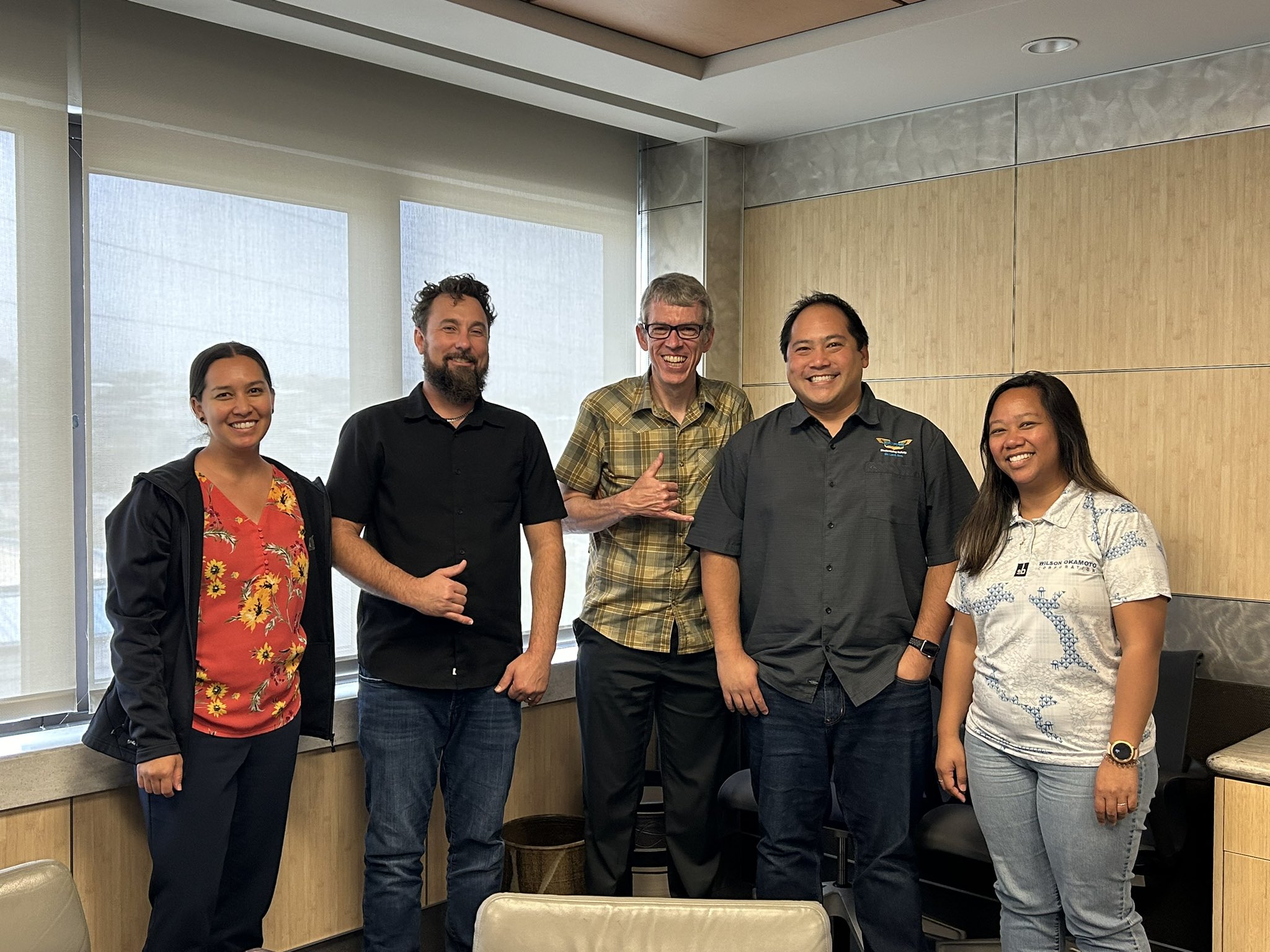December 2014 Section Meeting
On December 17, 2014, members and friends met for happy hour and networking at Gordon Biersch as a holiday gathering. The Hawaii Section also took this opportunity to acknowledge Dr. Constantinos S. Papacostas for all his accomplishments and contributions to Transportation Engineering upon his retirement
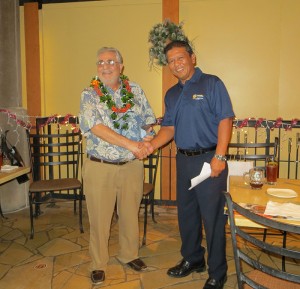 Born on the island of Cyprus, Papacostas came to the United States and earned a Bachelor’s degree at Youngstown State University and a Master’s and Ph.D. at Carnegie-Mellon University. He has been a professor at the University of Hawaii at Manoa since 1973, and the Chair of Civil and Environmental Engineering since 2010, engaged in teaching, research and training, consulting, and other advising activities for both the private and public sectors. As the Graduate Program Chair in the early 1990’s, he led the successful effort of establishing the doctoral program in Civil Engineering. He served as Director of the Hawaii Local Technical Assistance Program, organizing nearly 300 workshops for all workforce levels, and published the quarterly Hawaiian Connections, in which he was a frequent contributor of technical articles. Dr. Papacostas has been active in various local and national professional groups, serving as President for the Hawaii sections of the American Society of Civil Engineers, Institute for Transportation Engineers, and Hawaii’s oldest organization of its kind, Engineers and Architects of Hawaii. He has written numerous articles, reports, and publications, and received many awards for his various accomplishments to the profession. We are thankful for his contributions and wish him well in his retirement!
Born on the island of Cyprus, Papacostas came to the United States and earned a Bachelor’s degree at Youngstown State University and a Master’s and Ph.D. at Carnegie-Mellon University. He has been a professor at the University of Hawaii at Manoa since 1973, and the Chair of Civil and Environmental Engineering since 2010, engaged in teaching, research and training, consulting, and other advising activities for both the private and public sectors. As the Graduate Program Chair in the early 1990’s, he led the successful effort of establishing the doctoral program in Civil Engineering. He served as Director of the Hawaii Local Technical Assistance Program, organizing nearly 300 workshops for all workforce levels, and published the quarterly Hawaiian Connections, in which he was a frequent contributor of technical articles. Dr. Papacostas has been active in various local and national professional groups, serving as President for the Hawaii sections of the American Society of Civil Engineers, Institute for Transportation Engineers, and Hawaii’s oldest organization of its kind, Engineers and Architects of Hawaii. He has written numerous articles, reports, and publications, and received many awards for his various accomplishments to the profession. We are thankful for his contributions and wish him well in his retirement!
October/November 2014 Section Meeting
On Wednesday, November 5, 2014, the Section meeting was held at the Fasi Municipal Building. In the absence of President Pete Pascua, Director Mike Packard opened the meeting and announced that we do not have a section meeting scheduled for next month, but be on the look out for a happy hour for the month of December.
Vice President Natasha Soriano asked to go around the room and have everyone introduce themselves. Natasha introduced speaker Mark Garrity, Deputy Director of the City & County of Honolulu’s Department of Transportation Services, an AICP certified Urban Planner with over 20 years of experience.
Mark spoke about the King Street Cycle Track, which began construction on September 8, 2014, and should be completed in about 4 weeks to officially open on December 6, 2014. He explained that cycle track is a pilot project with the design done in-house and constructed by the City’s Department of Facility Maintenance with low cost materials. Mark went through a PowerPoint presentation and spoke about different aspects of the project. The green paint is a new FHWA standard for bike facilities, but there are various ways that it can be used. For King Street, the cycle track is being painted green through the intersections and in front of driveways to indicate a conflict between bicyclists and motorist. For the first 6 months the track will be for one way traffic, going with the flow of vehicular traffic. After the 6 six months the 10’ bike track will be divided for two way traffic, allowing bicyclist the convenience of being able to go back and forth on King Street, hopefully encouraging more bike use. Before data was taken, a travel time study allowed parking on King Street and found that it did not affect peak traffic flow, and therefore shifting King Street to 5 lanes from 6 should not heavily impact traffic. Bike counts were taken of bicyclists riding on the street, sidewalk, and parallel streets; and community outreach was conducted including community meetings with the Moiliili-McCully Neighborhood board and passing out flyers to every business along King Street. The project consisted of working with the stakeholders such as the City Council, Fire, Police, and the Hawaii Bicycling League, and public education was done through flyers as well as a project webpage and facebook page. The rules of the Track are no mopeds, skateboards, or segways, which means there needs to be a change in the law that currently says mopeds are supposed to be riding in the bike lane; drivers shall yield to bicyclists, and bicyclists shall yield to pedestrians.
Mark took the opportunity to share information about other bike developments. He had a slide about “sharrows,” pavement markings to indicate shared lanes for both vehicles and bikes. It was also mentioned that the other bike plans are still in effect, and when Beretania Street gets resurfaced soon, it will get a traditional bike lane.
Mark opened the floor to questions, and City Bicycle Coordinator Chris Sayers shared more information about the project as questions were asked. There was a good discussion amongst attendees, including how we educate everyone on the proper use, how do we encourage bicyclist to ride safely on this and other streets, and how will we know if the project has been a success or not.
September 2014 Section Meeting
On Wednesday, September 24, 2014, ITE Hawaii held their Section Meeting at the Kapolei State Building. Western District Secretary-Treasurer Cathy Leong announced that there is currently an RFP out to overhaul the Western District website for $10,000, if anyone is interested go to westernite.org. President Pete Pascua informed everyone that we are looking for ideas for speakers and events such as field trips and happy hour. If anyone has any suggestions please let any of the officers know.
Vice President Natasha Soriano introduced speaker Ross Hironaka from the State of Hawaii Department of Transportation to talk about the H-1 Rehabilitation Project. Ross spoke about his background, and how he’s been with the DOT for almost 27 years, 22 of which he has been a Project Manager. He explained that because this project was so large and unique, a design consultant was hired, but he was part of the overall decision making process. Parsons was the Consultant, Hawaiian Dredging was the Contractor, and Bow Construction Management Services was also part of the team. The purpose and need of this project was to alleviate congestion and improve safety. For the State, this project proceeded very quickly, starting only in August of 2012 and beginning construction in April of 2013. The biggest concern during the construction phase was to avoid the back to school and holiday rush, therefore, to minimize the impact to the public a compressed schedule was followed and night work had to be done. It was decided that full closures were needed so that the entire width of the freeway could be repaved in one lift. Because there was no engineering solution for mitigation, the focus was to make the public aware. Although very few people showed up to the public meetings, the media did, and that proved to be one of the best sources to getting the message out. HPD, fire, and ambulance, and also the Visitors Bureau were informed of when the full closures were going to take place and could adjust their routes accordingly. The public affairs office send out weekly notices to the DOT and the media, keeping the momentum going to continually keep the public aware of the construction activities. Having the information in the media and keeping the public aware proved to be a win/win/win, as the public heeded the message, and complaints were minimal. The H-1 Rehab public outreach campaign was recognized with an award from the Hawaii Chapter of the Public Relations Society of America for best integrated communications in the Government, Associations and Non-Profits category.
Ross opened the floor to questions. Several questions were asked and discussed among attendees, including the design exception for the substandard 10’ lanes. Test sections were first tried, and although the initial idea of 10’ lanes sounded a little scary for motorists, when in place the public responded favorably, and the 10’ lanes were continued as far as possible.
Pete thanked Ross for his presentation, and reiterated that we are looking for suggestions for speakers and events. It was also announced that we are looking to fill committee chair positions, and Cathy revealed that Brysen [Calkins] volunteered to serve as the student liaison chair.
July 2014 Annual Section Meeting
On Wednesday, July 30, 2014, ITE Hawaii’s annual meeting was held at the Fasi Municipal Building.
President Mike Packard opened the meeting, and turned it over to Vice President Brian Gibson.
Brian introduced speaker Maaza Mekuria, Ph.D., P.E., PTOE, from the State of Hawaii Department of Transportation. Maaza gave a PowerPoint presentation about Modeling and Evaluating Bicycle Networks Based on Traffic Stress and Origin Destination Connectivity. Maaza gave an interesting presentation on what is a bicycle network, including both low and high speed traffic areas. He explained connectivity as the first priority, and safety with undue detour. He talked about the 4 levels of traffic stress, and how only one percent of riders would fall into this traffic tolerant category. Maaza thanked Goro Sulijoadikusumo for encouraging him to give a presentation.
Director Steven Yoshida announced the results of the elections and Western District representative Cathy Leong swore in the new officers:
President – Pete Pascua
Vice President – Natasha Soriano
Secretary – Sara Toyama
Treasurer – Robert Nehmad
and Mike Packard will be the Director.
Cathy also announced that next year’s Western District Annual Meeting will be in Las Vegas.
May 2014 Section Meeting
President Packard opened the meeting, stating that all members should have gotten their Western ITE ballots by email. If not, let Cathy know.
Director Yoshida announced the candidates for Hawaii Section election:
President – Pete Pascua
Vice President – Natasha Soriano
Secretary – Sara Toyama
Treasurer – Robert Nehmad
Vice-President Gibson introduced speaker Cyndy Aylett and James Matsuzaki, from the City & County of Honolulu, to talk about the City’s Pavement Management System (PMS).
Cyndy Aylett, from the Department of Facility Maintenance presented a PowerPoint presentation about the PMS. She explained that the City was awarded a grant from the Oahu Metropolitan Planning Organization, and started the project in October 2012, to develop and implement the system that will program the money to be most effective. The City chose the MicroPAVER management system used by the US Army Corps of Engineers and earthmine images as the measurement technology which can be used by other departments as well. Cyndy explained that the Pavement Condition Index is determined by distress type, quality, and severity. She went over the factors impacting degradation and the different types of preservation treatments. James helped answer questions about the GIS aspects, and the presentation concluded with picture examples of the different PCI categories. The speakers took questions, and the attendees participated in discussion of pavement condition.
April 2014 Section Meeting
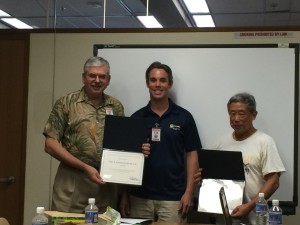 President Packard presented ITE Life Member Awards to Wes Frysztacki and Warren Yamamoto, for being ITE members for over 25 years, and reaching the age of 65 years old.
President Packard presented ITE Life Member Awards to Wes Frysztacki and Warren Yamamoto, for being ITE members for over 25 years, and reaching the age of 65 years old.
Western District Secretary-Treasurer Leong announced that District Elections are coming up, and ballots will be emailed to members.
Vice-President Gibson introduced speakers Brian Lock (Engineer, Wilson Okamoto), Eric Matsumoto (Structural Engineer, KSF, Inc.), and Laura Mau (Planner, Wilson Okamoto), to speak about this bridge he saw and wondered, why does it look upside-down?
Brian Lock spoke about the Honoapiilani Highway Realignment, Phase 1A as being a Design-Build project intending to alleviate traffic congestion along the Highway associated with the Lahainaluna school complex.
Lauren talked about the unexpected archaeological sites that were discovered just prior to construction, and shared the lessons learned from the community consultation. She found that the consultation process drove the project direction, that transparency of the DOT/FHWA participation was important, and even though she was reluctant at first, she found personal perspective in human equity from the passion of the community for stewarding.
Eric explained the design of the 360-foot Kahoma Bridge, a post-tension, inverted arch design structure that is under the travel-way and therefore does not obstruct the views. This design utilized friction pendulum into foundation bearings, and enabled the spanning of the stream with minimal impact, and included a 1200’ radius curve.
February 2014 Section Meeting
On Wednesday, February 26, 2014, the featured speaker was Randolph Sykes from the Oahu Metropolitan Planning Organization. Sykes presented a PowerPoint presentation of the “Final Alternative Scenarios Summary Report, Oahu Regional Transportation Plan 2035 Project,” prepared by Parsons Brinckerhoff. He explained that the Consultants forecasting model results found increasing interstate H-1 by four lanes in each direction would bring it up to Level of Service D. However, the study also indicated that the more capacity that’s provided the more people are going to want to use it, and we’ll have to continue to build out. A Managed Lane scenario was looked at, in which High-Occupancy Toll lanes on the H-1 would be free for vehicles with three or more persons while vehicles with less persons would be charged a fee. The presentation also included Cordon Pricing Scenario, charging a fee for vehicles entering the downtown Honolulu area, bounded by River Street, Nimtiz Highway/Ala Moana Boulevard, South/Alapai Streets, and Vineyard Boulevard. The full report can be found on the www.oahumpo.org website.
January 2014 Section Meeting
President Packard called the meeting to order at 12:00 pm. He welcomed attendees and asked each person to introduce themselves and the organization they were with.
Vice-President Gibson announced that the topic for the next meeting would be a summary of planning-level analysis that was done for the Oahu Regional Transportation Plan concerning.
Warren Yamamoto made an announcement regarding Engineer’s Week.
Alan Fujimori began the presentation by giving some background on Complete Streets, Bill 26, and past Complete Streets demonstration projects.
President Packard presented information regarding Hele on Kaka’ako, which transfigured three blocks of Cooke Street into a temporary Complete Street with curb bulb-outs, mini traffic circles, and parklets. He said that they first looked at what other cities did and tried to learn from their experiences, and emphasized the liability issues of putting non-standard items in the road. The group had to develop plan sets, which were checked and verified by the Department of Transportation Services. He discussed the construction of the temporary features and the traffic simulation modeling that showed that average speeds were faster with the mini traffic circles than with the current stop conditions at two of the intersections.
Mr. Fujimori then presented information on 2014’s effort, Hele on Kalihi, including the existing conditions, public workshops that were held to help define and refine the effort, and the current plan which will be put into effect in May of 2014.
Both men then took a few questions from the audience.
Cathy Leong made a few district ITE announcements, including a re-branding effort, the Western District ITE meeting in Rapid City, and the candidates for the Western District election.
The meeting adjourned at 1:10 pm.
By Brian Gibson

